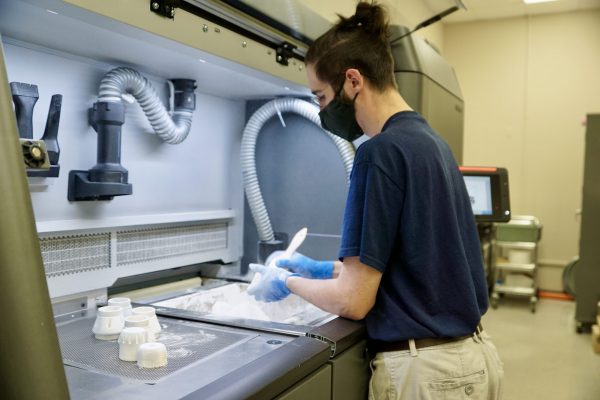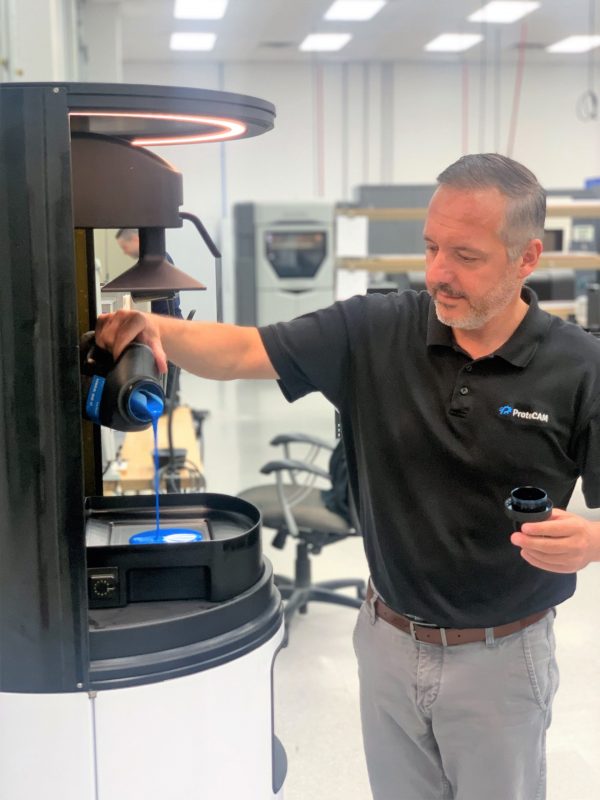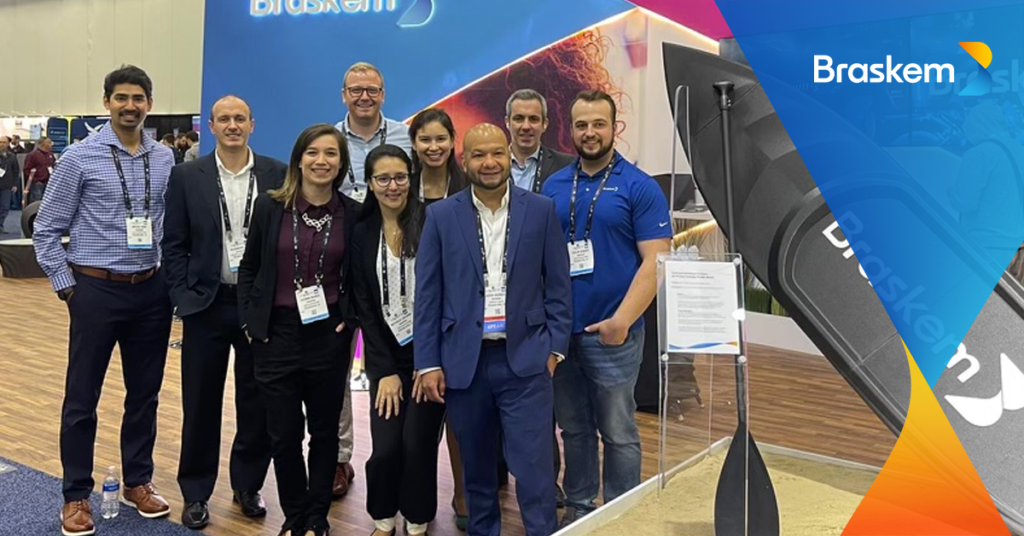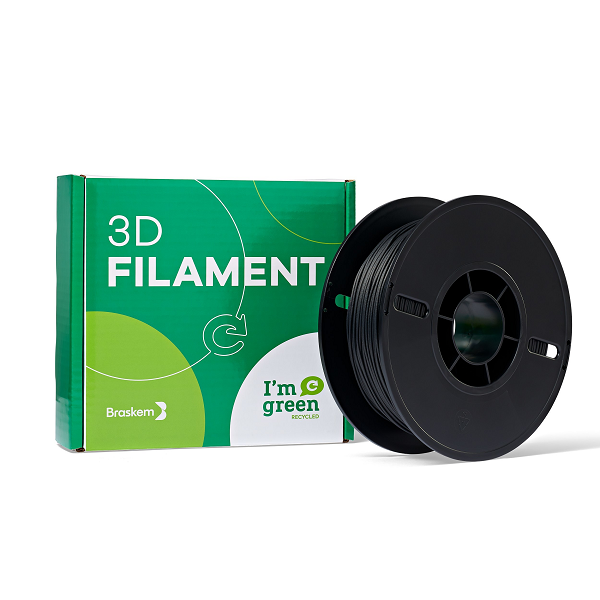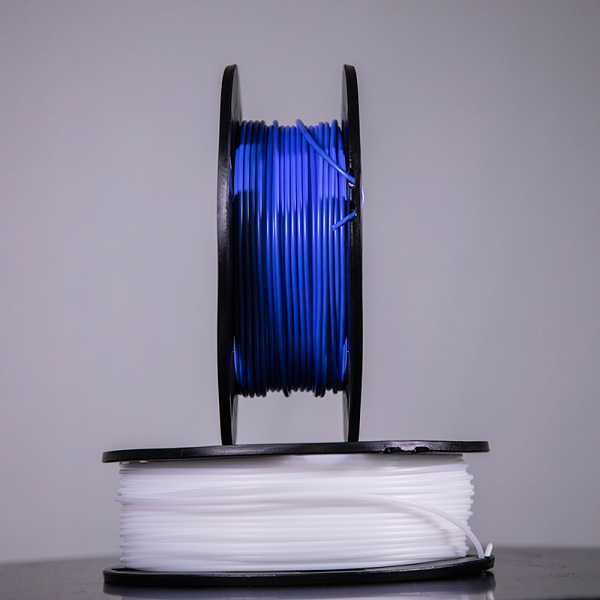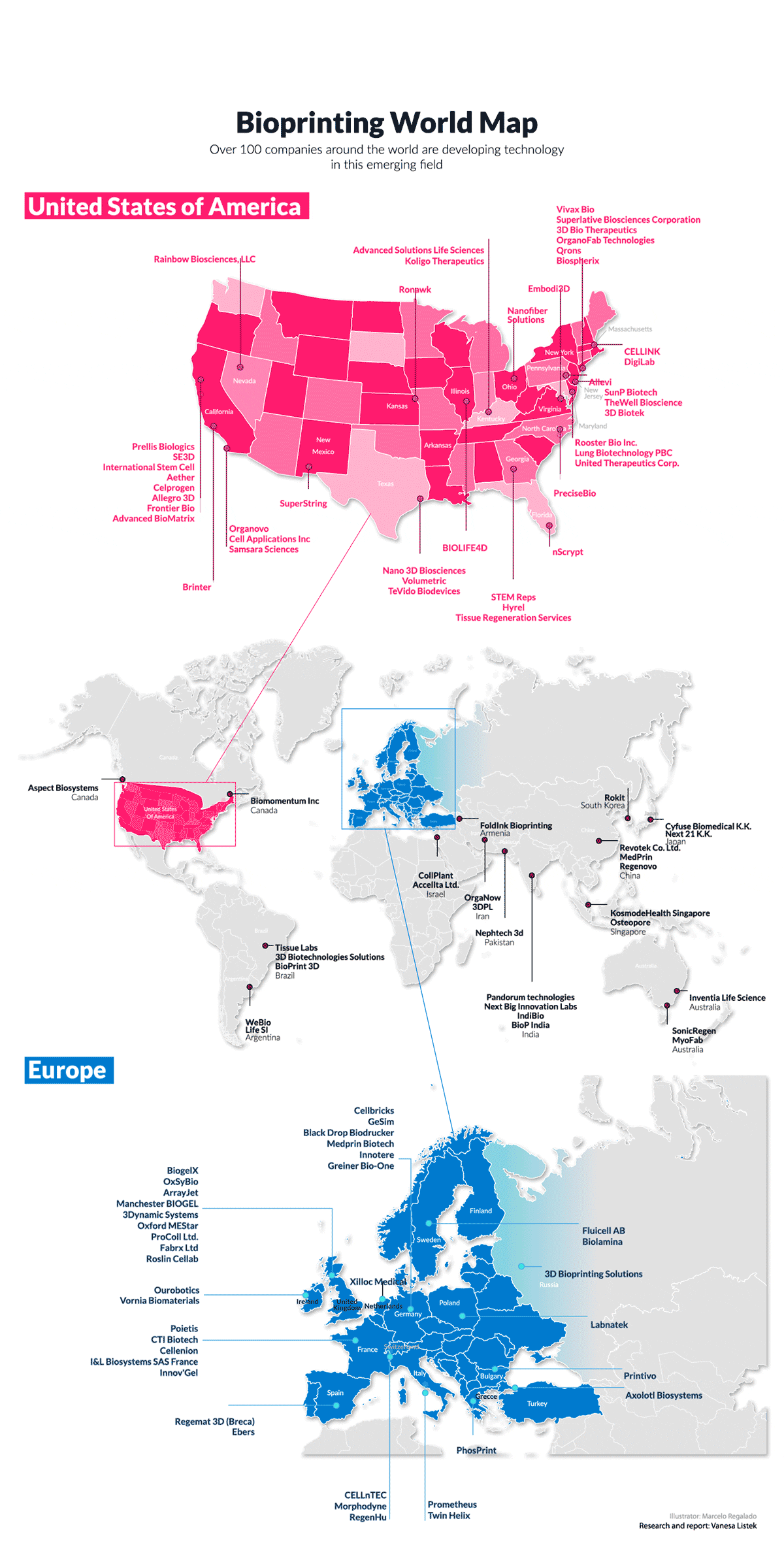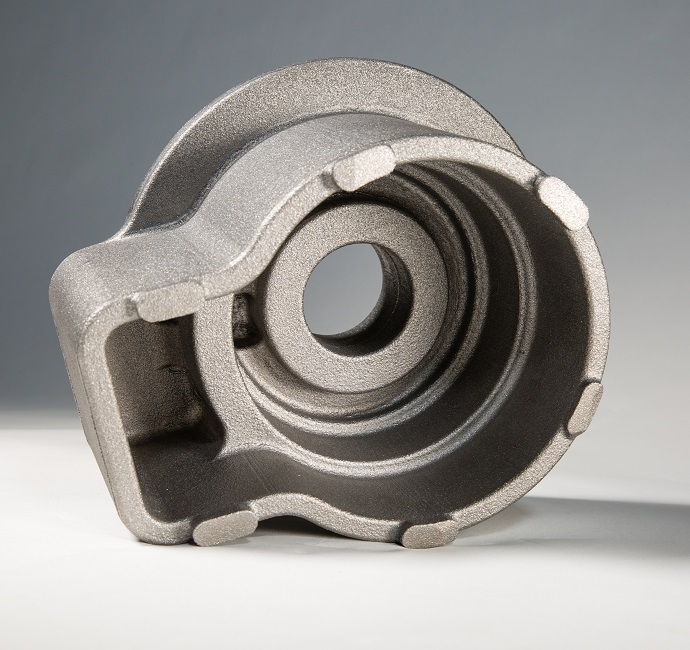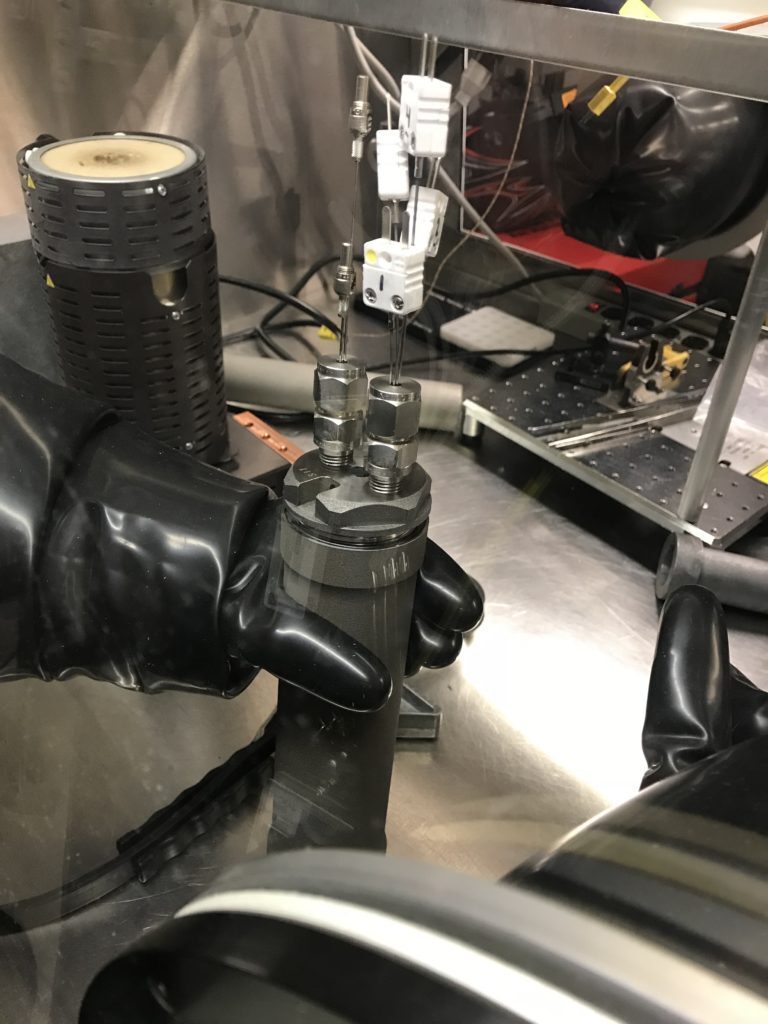3DPrint.com | The Voice of 3D Printing / Additive Manufacturing |
- rp+m 3D Printed the Seats for Boeing’s Starliner Spacecraft
- Prototek Adds Polymer 3D Printing Capabilities with ProtoCAM Purchase
- Catching Up with Braskem at RAPID + TCT: Expanding Available Additive Materials
- Revisiting 3DPrint.com’s Bioprinting Zone: An Evolving Startup Landscape and World Map
- New 3D Printing Industries: Nuclear Industry
| rp+m 3D Printed the Seats for Boeing’s Starliner Spacecraft Posted: 20 Jun 2022 06:30 AM PDT 3D printing service bureau Rapid Prototype and Manufacturing (rp+m) revealed via social media that a team of engineers at its Ohio headquarters had 3D printed the seats used by Boeing's Starliner spacecraft, which launched to the International Space Station (ISS) on an un-crewed NASA flight test on May 19, 2022, and safely returned to Earth six days later.
Furthermore, rp+m Additive Manufacturing Engineer Cameron Rogers didn't only confirm that the company was behind the 3D printed seats for the Starliner, but he also said rp+m printed "three different sets which varied slightly in size." For the task, rp+m relied on Stratasys' fused deposition modeling (FDM) technology which works with specialized 3D printers and production-grade thermoplastics to build strong, durable, and dimensionally stable parts. Specifically, Tom Leach, the commercial leader for FDM at Stratasys, said the team had used the F900 large-build volume printers and ULTEM 9085 resin 3D printing material to make the seats. 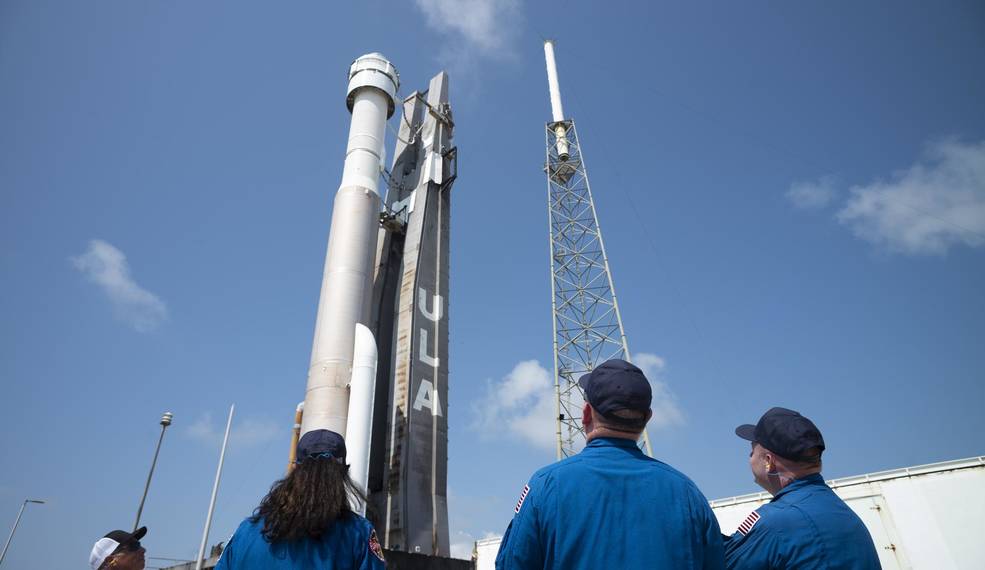 NASA astronauts watch as a United Launch Alliance Atlas V rocket with Boeing's CST-100 Starliner spacecraft aboard is rolled out to the launch pad ahead of the Orbital Flight Test-2 mission. Image courtesy of NASA/Joel Kowsky. Manufactured by Boeing, the Crew Space Transportation (CST)-100 Starliner is a class of two partially reusable spacecraft designed to transport crew to the ISS and other low Earth orbit (LEO) destinations as part of the aerospace giant's contribution to NASA's Commercial Crew Program. Along with SpaceX, Boeing was tasked with building a spacecraft to replace the Space Shuttle and free the U.S. of its decade-long reliance on Russian Soyuz capsules to access the orbiting station. SpaceX gained ground after launching its first crewed mission aboard the Falcon 9 rocket in 2020 and is now regularly flying crew to the ISS. Boeing, however, has encountered a series of problems as it tries to get Starliner up and running for actual crewed missions. This last test flight, known as Orbital Flight Test 2 (OFT-2), is a redo of the OFT-1 test, which launched in December 2019 but ended prematurely after the Starliner malfunctioned due to software adversities that caused the capsule to burn through propellant shortly after launch, failing to reach the ISS. Boeing addressed the issues and got Starliner ready to launch on OFT-2 in the summer of 2021, but preflight checks shortly before the planned liftoff revealed 13 stuck valves on the capsule's service module propulsion system that were not responding to commands. Since Aerojet Rocketdyne is the official hardware supplier for the Starliner's service module propulsion system, the two companies have clashed over the defective fuel valves, stated a recent Reuters report. Since then, Boeing spent roughly eight months working on solving the issues that delayed the flight. Once the valve issue on the spacecraft was resolved, OFT-2 finally got off the ground. That was great news for the rp+m team, which finally got to witness its 3D printed seats in orbit. Aboard the seat was "Rosie the Rocketeer," Boeing's anthropometric test device named after World War II's Rosie the Riveter as an ode to the women who have blazed a trail in aerospace and human spaceflight. Rosie was strapped into the Starliner for its flight test, this time to help the spacecraft maintain its center of gravity throughout the various phases of the flight.
For OFT-2, spacecraft data capture ports previously connected to Rosie's 15 sensors were used to collect data from sensors placed along the seat pallet, which is the infrastructure that holds all the crew seats in place. The sensors can capture data to characterize the motion of all four crew seats, explained Crew Module Chief Engineer Dan Niedermaier. Wearing a Boeing blue spacesuit and red polka dot head scarf, Rosie also sported a matching face mask hand-sewn by 95-year-old Mae Krier, a real-life Rosie who helped build planes in a Boeing factory in Seattle when she was 17 years old.  The Starliner anthropometric test device, Rosie the Rocketeer, wore a hand-sewn Rosie-themed COVID-19 mask and an autographed Rosie scarf during the Starliner capsule's Orbital Flight Test 2. Image courtesy of Boeing. Boeing's contract with NASA covers the unpiloted OFT-1 and OFT-2 missions and a Crew Flight Test expected to launch with two astronauts, Barry "Butch" Wilmore and Suni Williams, late this year or early next year. The first crewed test flight will lift off atop a United Launch Alliance Atlas V rocket from Space Launch Complex-41 at Cape Canaveral Space Force Station in Florida, just like OFT-2. Once the test flights are completed, NASA will begin the final process of certifying the Starliner spacecraft and systems for crew missions to the space station. Regular, long-duration commercial crew rotation missions enable the agency to continue the research and technology investigations aboard the orbiting laboratory and lay the groundwork for future exploration of the Moon and Mars. The post rp+m 3D Printed the Seats for Boeing’s Starliner Spacecraft appeared first on 3DPrint.com | The Voice of 3D Printing / Additive Manufacturing. |
| Prototek Adds Polymer 3D Printing Capabilities with ProtoCAM Purchase Posted: 20 Jun 2022 06:00 AM PDT Rapid prototyping company Prototek Holdings has purchased Allentown, Pennsylvania-based ProtoCAM Additive Manufacturing. The company will be integrated into Midwest Prototyping, which Prototek acquired last year. John Pless, Partner at TruArc Partners and a Director of Prototek, said about the acquisition:
ProtoCAM will add polymer 3D printing capabilities to the Prototek firm, including more SLA and HP’s MJF capacity, as well as FDM. The current ProtoCAM team will be kept in place. Steve Grundahl, Vice President of Additive Manufacturing, Prototek, stated,
Ron Belknap, Founder and CEO of ProtoCAM, said,
ProtoCAM was founded in 1994 and is a strong regional player in 3D printing as well as casting. The company offers urethane and wax casting, as well as SLA casting via 3D Systems´ QuickCast technology. The latter can be used for investment casting, offering a faster turnaround than traditional investment casting patterns.
This acquisition is part of an expected consolidation of the 3D printing and on-demand manufacturing market. When we spoke to Steve Grundahl last year, it was already apparent that Prototek was on the path to more acquisitions. The company has investors behind it and is essentially doing a roll up strategy for 3D printing and CNC services, though the markets for these are very fragmented. Companies are regional or local and tend to have strong local business relationships, but are unable to leverage these to go national or international. Players are also often constrained by their ability to seek financing since they are too old for VCs as businesses, but a little too new for many banks. There is a strong case to be made for a truly national US on-demand manufacturing firm, especially with the focus now more on “made in America,” and the Ukraine war, and a more aggressive China making the case for more, stronger manufacturing in the US. Less supply chain interruptions and more true American manufacturing independence, especially for defence spending, seems like a good bet. At the same time, the current state of SPACs, the ebb of the deal flow in new SPACs and VC funding, as well as the economic outlook, all give independent operators pause. Expanding fast now, and finding cash now, will be hard, and the companies would have to wait a long time for valuations to increase again. So it seems like a good time to sell up for a lot of people. A national on-demand 3D printing champion will be a strong candidate for a lot of DoD business and could leverage advertising and online clout to become a truly national player. A strong national 3D printing service would also be an almost irresistible morsel for Precision Castparts once they come to their senses. Other manufacturing firms could also be very interested in acquiring a fast moving, growing portion of a diversified manufacturing firm when the time comes to flip Prototek. So this is a future anticipated, and we would expect Prototek to be on the warpath again to outgrow Protolabs and others vying for industry dominance. The post Prototek Adds Polymer 3D Printing Capabilities with ProtoCAM Purchase appeared first on 3DPrint.com | The Voice of 3D Printing / Additive Manufacturing. |
| Catching Up with Braskem at RAPID + TCT: Expanding Available Additive Materials Posted: 20 Jun 2022 05:30 AM PDT During the COVID-19 outbreak, there was one important multinational that jumped into the additive manufacturing (AM) industry without the typical fanfare. This was Braskem (NYSE: BAK), the largest petrochemical company in Latin America and the largest polyolefins producer in the Americas. To make a more official entrance into the sector, the company attended RAPID + TCT, where it displayed a broad range of polyolefin and biopolymer materials for 3D printing. 3DPrint.com caught up with Jason Vagnozzi, Braskem Global Commercial Director of Additive Manufacturing, to learn more. At the event, the firm presented polymers for a diverse set of 3D printing processes, including fused filament fabrication (FFF), selective laser sintering (SLS), and high-speed pellet extrusion. Among them was a new line of sustainable materials. Vagnozzi walked us through the portfolio as he answered our questions.
Braskem's Sustainable 3D Printing FilamentsOf particular importance were the sustainable materials. Humanity has essentially reached peak resource while pushing the ecosystem past its limits in terms of biodiversity loss and greenhouse gas emissions. For those reasons, it's essential to immediately shift to a less resource intensive way of living. Braskem's solution is a new line of filaments, beginning with raw sugarcane-based ethylene vinyl acetate (EVA), as well as recycled polyethylene and polypropylene (PE/PP) blended filaments with, or without, carbon fiber. The sugarcane-based FL600EVA-BIO is an extremely flexible material with properties somewhere between a thermoplastic elastomer and a thermoplastic polyurethane (94 Shore A hardness, elongation at break > 500%). About 87 percent comes from sustainable source materials, with the remaining percentage made up of materials to make it more durable and easier to process. This material comes from Braskem's bio-based polymer manufacturing operations in Brazil, where the company has spent more than a decade harvesting raw sugarcane for injection molding plastic. It's pitched as being ideal for consumer, packaging, and industrial markets. As for the recycled PE/PP, Braskem relies on suppliers of mechanically recycled plastic, which undergoes an internal audit to ensure that the materials meet the company's quality standards. FL600R is made up of 90% recycled bottlecaps, as is its counterpart, FL605R-CF, with the addition of recycled carbon fiber reinforcement. Both are low-density plastics with the water, chemical, and impact resistance found in virgin polyethylene and polypropylene. FL605R-CF is obviously stronger and more durable than the non-reinforced variety. The price of oil has fluctuated wildly since COVID began and, due to the lack of easily accessible fossil fuels, seems to be heading toward permanently higher oil prices. I asked if the high cost of oil played a role in Braskem's decision to pursue more renewable materials. Vagnozzi replied:
Braskem's 3D Printing StrategyWith the company's history as a producer of PP, PE, and PVC, Braskem aims to expand the available materials in the additive market.
On display at the Braskem booth were a wide variety of these materials in various forms. This included: Filaments
Pellets
Powder
This is just the beginning for the Brazilian giant. Being comparatively unknown to the additive manufacturing market, Braskem will continue to partner with existing companies like ALM for powders, Ultimaker for filaments, and Titan Robotics for pellets. Speaking of the SLS material, Vagnozzi said, "This was our first foray into powder. What you’re going to see from us over the next 24 months is an expanded powder portfolio. Now that we've cracked that basic code, we’re going to quickly accelerate, iterate, and bring in more materials." As it does so, Braskem may also play a role in consolidating the materials industry, Vagnozzi revealed.
In other words, AM materials businesses may want to keep an open line of communication open with Braskem, as they may be interested in performing some market consolidation. Otherwise, keep an eye out for more materials from the Brazilian chemical company, as we can expect a lot more from Braskem in the near future. The post Catching Up with Braskem at RAPID + TCT: Expanding Available Additive Materials appeared first on 3DPrint.com | The Voice of 3D Printing / Additive Manufacturing. |
| Revisiting 3DPrint.com’s Bioprinting Zone: An Evolving Startup Landscape and World Map Posted: 20 Jun 2022 05:00 AM PDT Ever since 3DPrint.com created the Bioprinting Zone and published the first world map of bioprinting companies in June 2019, things have changed a bit. Not only did many businesses succumb to the economic shock of the Covid-19 pandemic, but several others were also acquired by bigger companies, changed their names, and even moved to another country. So, with quite a few changes in the bioprinting realm, it might be a good time to revisit our map and the industry's evolution. Bioprinting is very much tied to the groundbreaking research done by academia, institutions, and the medical community. Only a handful of firms began commercializing bioprinting technology ten years ago. Pioneering the segment was Organovo, a company created in 2007 that was on the cusp of commercializing tissue patches for the treatment of liver disease and is now struggling to survive. Around that same time, other businesses emerged, like Switzerland-based regenHU, which unveiled new products until 2020 but ran into several problems keeping afloat. Other front runners such as DigiLab and Cellink have changed their names to Cellular Life Sciences and BICO (STO: BICO), respectively, but managed to remain at the forefront of the private bioprinting industry, creating some of the most sought after machines in the market. Actually, BICO has become a powerhouse. After rebranding in 2021, net sales grew by more than 600%, driven by a spree of mergers and acquisitions (M&As) as well as its own organic growth. The strategy to acquire complementing technologies to cover the entire bioprinting workflow began in 2018, when BICO took over the German provider of automated liquid handling instruments, Dispendix. Following that first move, the company acquired 12 other startups, including Allegro 3D. But even though business seems flawless at BICO, news of an internal rift that started after the departure of one of the company's co-founders and Chief Financial Officer (CFO), Gusten Danielsson, has agitated the waters a bit. In late April 2022, Danielsson, responsible for strategizing BICO's economic direction, said CEO Erik Gatenholm was "no longer the right leader for the company, even if he remains a controlling shareholder." The internal battle is not over yet, but that hasn't seemed to stop the company from moving forward with its strategy.  Sanjay Gupta holding the 3D printed lung scaffold. Left to right: Sanjay Gupta, Mark Hodosh, Martine Rothblatt and Chuck Hull. Image courtesy of 3D Systems. One of the most strategic moves in the industry came from 3D Systems (NYSE: DDD). Although the company's strong suit is its broad portfolio of industrial additive manufacturing solutions for plastic and metal parts, 3D Systems has an established reputation in the medical field. But now, it is diving further into the bioprinting space. Over the last years, a staggering demand for bioprinting and regenerative medicine led AM pioneer and 3D Systems co-founder Chuck Hull to establish a bioprinting unit within the company. Currently serving as Chief Technology Officer for the company, the 81-year-old inventor and his team have made strides in the last two years. Following a successful collaboration with biotech firm United Therapeutics Corporation (NASDAQ: UTHR) and Lung Biotechnology PBC, its organ manufacturing subsidiary that began in 2017, the companies extended their partnership. In June 2022, they even showcased a fully printed human lung scaffold at the CNN-sponsored Life Itself conference. This exciting milestone represents one of the most complex objects ever printed and what Hull describes as "the culmination of our efforts with United Therapeutics." As part of their collaboration, the duo is already working on developing two other organs, kidneys and livers. Reassessing our bioprinting world mapAs part of our original research of bioprinting companies, we amassed a database that encompassed a spectrum of different bioprinting businesses in a wide range of countries. In 2019, we reported that the U.S. was the leading force, with 39% of the companies headquartered in 18 states. Today, the country is still the leader in the bioprinting industry, with 40% of the companies based in 16 states. In addition, Canada is home to three large bioprinting companies, making North America the leading region for emerging bioprinting companies. The European continent follows with 38% of the companies (in 2019, that number was 35%), followed by Asia with 17% (a number that remains stable from 2019), Latin America with a mere three companies, and Australia (representing Oceania) with just one. Countries like the U.K., Germany, and France continue to absorb most of the business, just like in 2019. Similarly, China remains the region's driving force in Asia with four companies, except that now, India, Iran, and Israel also have their startups working on bioprinting hardware, software, and materials. A few countries have lost many bioprinting companies since 2019; namely, Italy, Australia, and Ireland, each witnessing at least two startups closing. For example, both Ourobotics and Vornia Biomaterials shut down in Ireland, leaving the scene without any bioprinting companies. Similarly, in Italy, we couldn't find one bioprinting business, even though it used to have three. Today Australia, one of the most innovative countries behind bioprinting research (mostly at universities and hospitals), only has one bioprinting startup, Inventia Life Sciences. No matter how much the landscape changes for the bioprinting industry, we continue to see many of its players thrive and new ones emerge. While still quite a niche sector, it is a reckoning force that can lead to incredible breakthroughs. Although the ultimate goal of bioprinting organs for human transplant is still a long way away (experts estimate between 15 and 20 years before clinical trials even see the light of day), the fact that we continue to witness bioprinting companies laying the groundwork for what is to come is fascinating. Our bioprinting world map may have changed in the last three years, but we expect it to change even more as the industry moves from the niche to the masses in the coming decades. The post Revisiting 3DPrint.com’s Bioprinting Zone: An Evolving Startup Landscape and World Map appeared first on 3DPrint.com | The Voice of 3D Printing / Additive Manufacturing. |
| New 3D Printing Industries: Nuclear Industry Posted: 20 Jun 2022 04:30 AM PDT The nuclear power industry is often overlooked. If we talk about nuclear power it’s usually a discussion about whether it is the solution to our climate change woes or an inherently dangerous technology. Nuclear power is always associated with risk due to Fukushima and other nuclear accidents. The industry results in some of the most technologically advanced, complex and expensive construction projects that humankind undertakes. Right now there are 53 nuclear power plants under construction. Each one costs around $5 to $9 billion to build. In some cases cost overruns have doubled cost estimates. Now with rising interest rates, these expensive plants will be a bit less likely, and the cost to build plants per kilowatt far outstrips that of other sources of energy. Nuclear is a very efficient power-generating technology overall however, and gives countries energy independence that doesn’t depend on the weather. There are around 440 operational nuclear reactors in existence right now and the maintenance on them is also a substantial business. Companies such as TerraPower have also reinvigorated the market by offering newer nuclear technologies. Meanwhile, industry giant Toshiba has been in a state of financial discombobulation due to its purchase of the Westinghouse nuclear business. The future of nuclear is far from assured. But, it is still going to be a considered technology and if it could be safe, would solve all of our energy problems. We’re already seeing a lot of things happening with 3D printing in the nuclear industry. The University of Pittsburgh looked at making AM more efficient specifically for the nuclear energy industry. GE and Hitachi cooperated on a similar project to reduce the costs of AM. At Purdue, researchers are trying to 3D print microreactors. Also, Desktop Metal´s printers are being used to print silicon carbide parts for the Ultra Safe Nuclear Corporation (USNC). 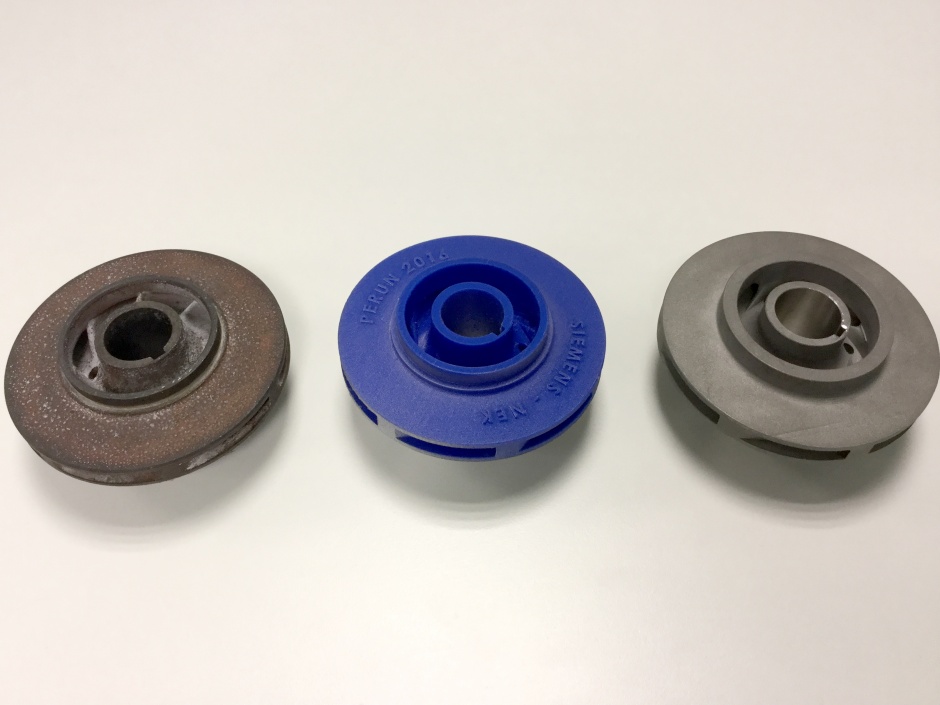 From left to right, the original, obsolete impeller; the 3D printed prototype; and, the resulting 3D printed replacement part (Image: Siemens) Siemens has installed at least one 3D printed part on a working nuclear power plant. First announced in 2017 for Slovenia´s Krško Nuclear Power Plant (NEK), these parts are helping to reduce maintenance costs. The first Siemens part was a 108 mm diameter metal impeller for a fire protection pump. The impeller´s manufacturer was out of business, making this an excellent case for the part to be 3D printed.
Westinghouse in turn has also 3D printed components for reactors. The firm demonstrated part integration as well as consolidation, and we know that reducing assembly steps through 3D printing can significantly reduce costs when quality is expensive and paramount.
Idaho National Lab has also looked at 3D printing safety testing and qualification equipment to make it faster and less expensive to create new parts for the nuclear industry. 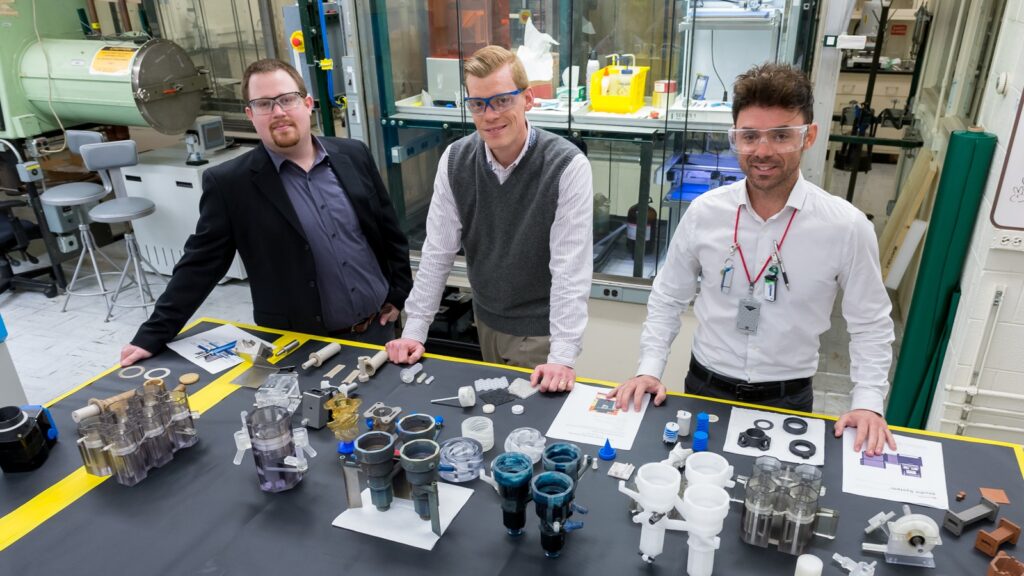 32783D, CFCT chemists group: Andrew Breshears, Peter Kozak, Alex Brown Argonne National Lab scientists used 3D printing to make nuclear fuel recycling more efficient. The scientists believe that they could recycle up to 97% of used fuel produced by nuclear reactors through their continuous ALSEP process. They used a lot of 3D printed parts in their designs, with some even being made on Formlabs desktop 3D printers. 3D printing makes for more efficient fluid movement, and also allowed for more components to be integrated. In another project, Argonne researchers were looking to recycle molybdenum more efficiently as well. 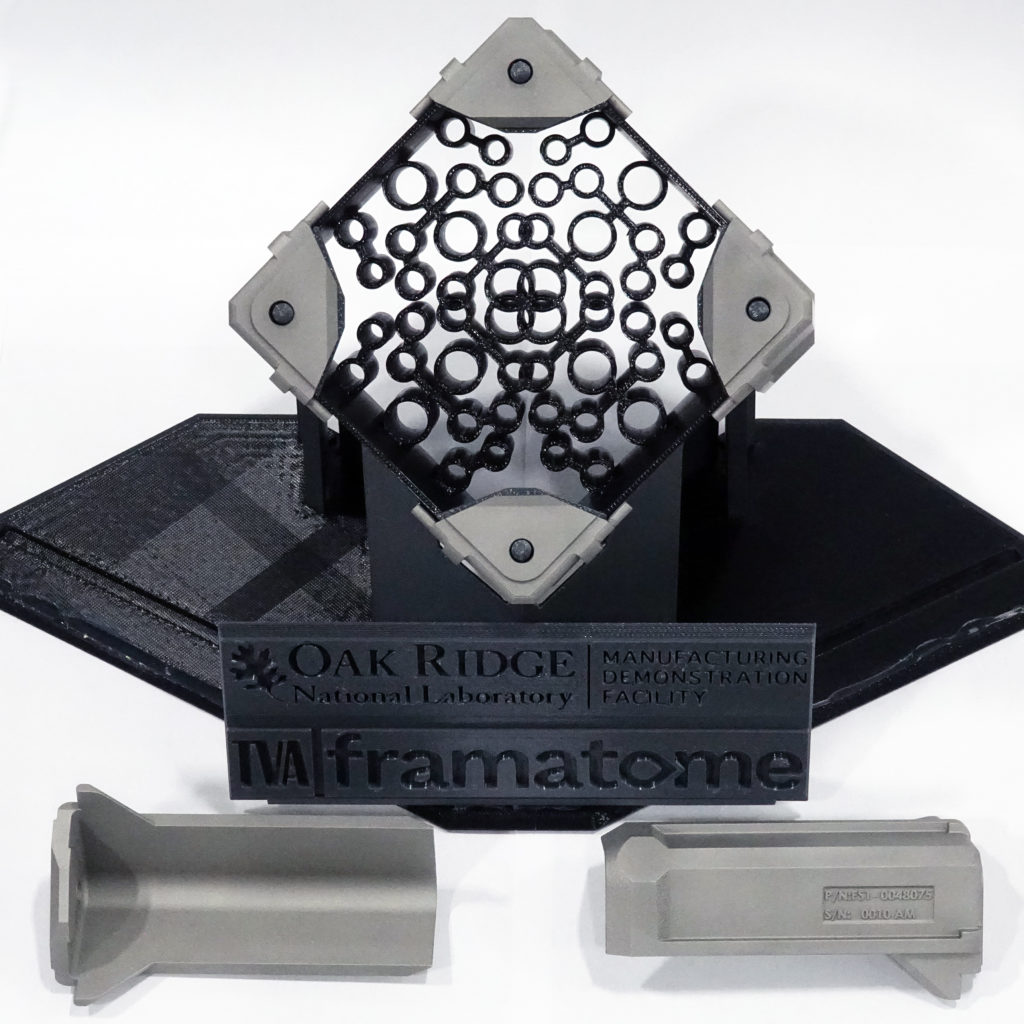 These fuel assembly brackets, manufactured by ORNL in partnership with Framatome and Tennessee Valley Authority, are the first 3D printed safety-related components to be inserted into a nuclear power plant. Image courtesy of Fred List/ORNL, U.S. Dept. of Energy ORNL has made parts that have been used on a TVA nuclear reactor. These parts, made in cooperation with Framatome, are safety critical faster components. The “components secure the fuel channel to the boiling water reactor fuel assembly, with the fuel channel wrapping around the assembly and directing coolant through the fuel rods.” Every print layer was logged to ensure quality. ORNL has also licensed a refractory metals Electron Bean Melting technology, as well as a binder jet with chemical vapor infiltration 3D printing method, for use in the 3D printing of reactor components. In addition, ORNL also used DED to make nuclear reactor cores. 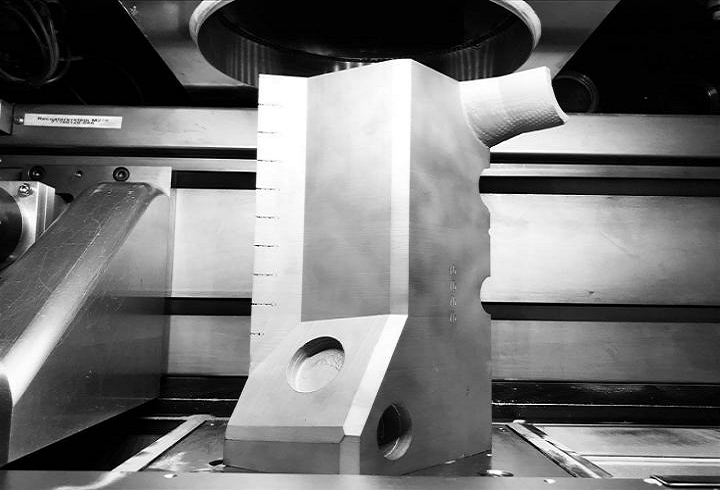 3D printed part for nuclear fusion test reactor. [Image: Dr. Leifeng Liu, University of Birmingham]
Another Chinese group is looking to optimise the core tritium production unit of nuclear fusion reactors with ceramic slurry components, such as those that can be made with Admatec or Lithoz. In the development of a new generation of fusion reactors, and in the ongoing Tokamak projects worldwide, 3D printing could play an increasing role as well. In safety critical use cases, we know that part consolidation provides us with a lot of advantages. There is less assembly cost. Also, fewer assembly steps mean that there is lower risk. If we eliminate steps, we also eliminate human error, which could cause things like fasteners, welds, brazing and glue to react adversely or fail as well. In essence we are concentrating our manufacturing risk on the 3D printing step. We’re having less human interaction with parts and less parts being stored and carried around a lot as well. We can optimise fluid transfer through making internal channels that are more highly optimised. We can direct fluid better but also slow it down, speed it up or heat and cool it more efficiently. We know that we can reduce mass through 3D printing as well. This is especially important, since every cubic centimetre of space that we save in a nuclear reactor means that we have to use less steel and concrete to encase it. Small savings could therefore have huge implications for construction projects. In developing new parts and making them, we could also potentially save money as well. Slightly more optimal surface textures or part properties could also have dramatic effects over the lifetime of a plant and its efficiency. There is significant volume in obsolete parts as well in all of the 440 plants currently in existence. There are also a lot of impellers and turbines in nuclear and other power plants, and we are particularly good at making those components. Nuclear energy also uses a lot of hard materials that are difficult to make with curing processes, and plenty of exotic materials that are difficult to make in general. Given the reach and criticality of the components in the nuclear industry, this is one sector that is currently being overlooked and should deserve more of your attention. The post New 3D Printing Industries: Nuclear Industry appeared first on 3DPrint.com | The Voice of 3D Printing / Additive Manufacturing. |
| You are subscribed to email updates from 3DPrint.com | The Voice of 3D Printing / Additive Manufacturing. To stop receiving these emails, you may unsubscribe now. | Email delivery powered by Google |
| Google, 1600 Amphitheatre Parkway, Mountain View, CA 94043, United States | |
